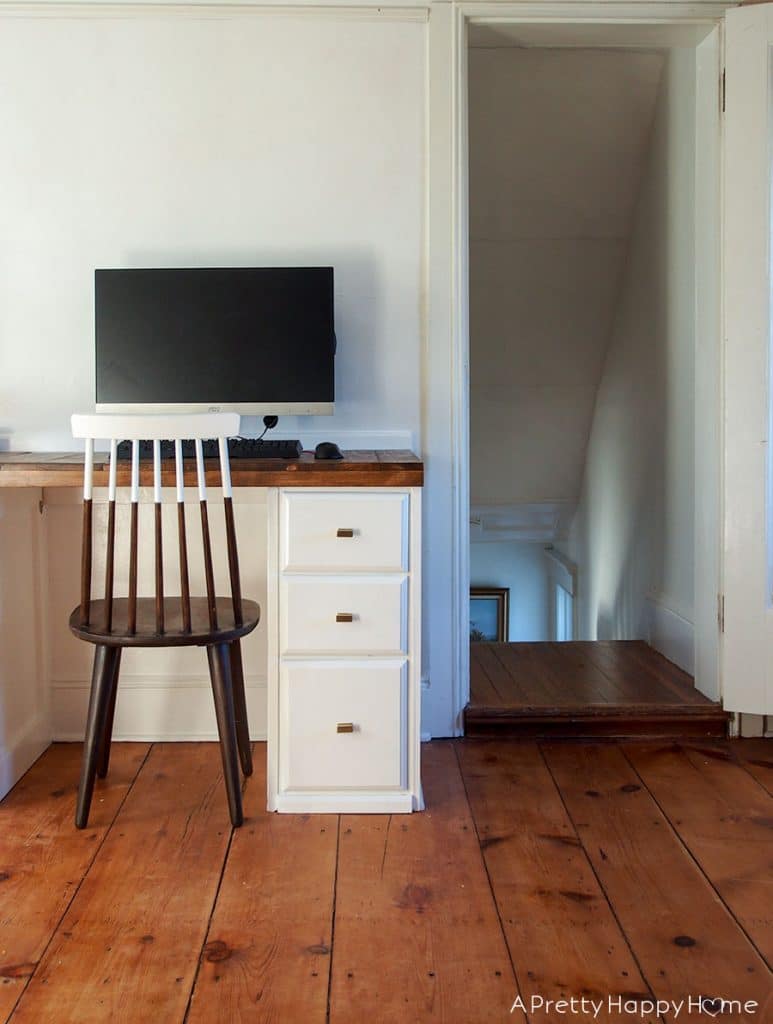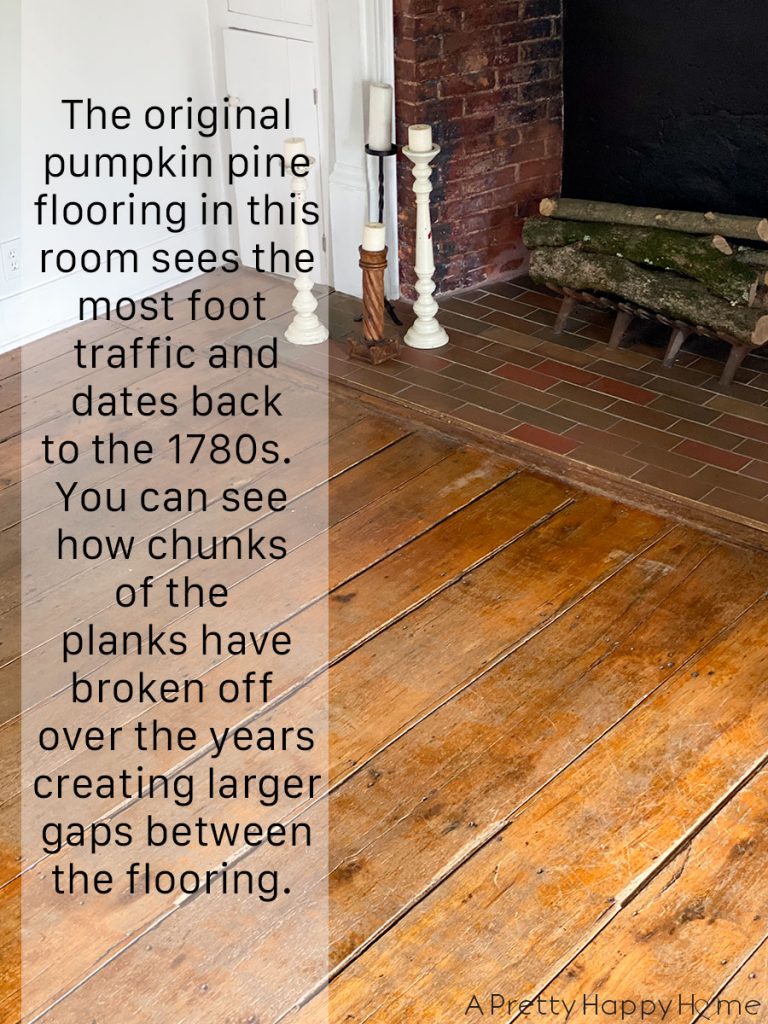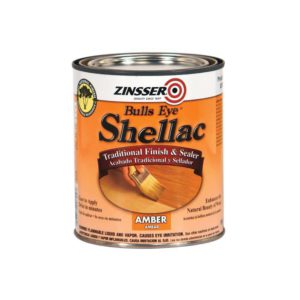
All About Our 240-Year-Old Pumpkin Pine Wood Floors
I have been unabashed in my utter love for and devotion to the original pumpkin pine wood floors in our Colonial Farmhouse.
It was love at first sight.
In fact, I might have discounted the problems our Colonial Farmhouse had because those floors were the rose-tinted glasses through which I viewed this money pit.
Can you blame me?
Look at these floors! Hubba hubba.
The oldest part of our Colonial Farmhouse dates back to the 1780s. Additional rooms were added on in the early to mid 1800s.
I’ve been so used to living with modern (1930s and after) hardwood floors that I didn’t realize how much I had to learn about pumpkin pine wood floors that are 240 years old or so.
Yes, I realize it is funny to call hardwood floors that are over 100 years old modern. Compared to the flooring in my home, those floors are modern! Everything is relative.
WHAT TYPE OF HARDWOOD FLOORS DO WE HAVE?
The floors in the oldest areas of our home are what is commonly referred to as pumpkin pine. Pumpkin pine flooring actually comes from Eastern White Pine trees, which are common to the eastern United States. We live in New Jersey.
In fact, Eastern White Pines were so common in the colonial era that practically everything from that time was built using this type of wood.
You’d think that wood that has lasted well over 200 years must be a very dense hardwood.
Nope!
Eastern White Pines are considered relatively strong and well-suited for construction uses. Particularly in colonial times, the forests would have been comprised of old growth timber. The wood from these trees would have had an extremely tight grain making it stronger and more durable than what is grown and cut down today.
However, Eastern White Pines are classified as a softwood. When it comes to flooring applications, this type of wood will dent and ding fairly easily. We’ve seen this happen in our home. I call it patina!
Furniture builders from the colonial era would have chosen a true hardwood like cherry to make furniture it they didn’t want the wood to ding and dent with use.
HOW WERE OUR PUMPKIN PINE WOOD FLOORS LAID?
The reason it is SO OBVIOUS that our pumpkin pine wood floors are very, very old is that the wood planks were cut and laid down very differently from modern wood flooring.
First, our floor planks vary in width from 8 – 16 inches. Some of the planks are up to 18-feet long and span an entire room.
There is no specific pattern to the width of the planks. We might have three 10-inch wide planks side-by-side and then there will be one 16-inch wide plank.
This is because creating wood flooring was a tough process done without the luxury of power tools. Have you ever used a hand saw to cut a piece of wood? Now imagine doing something like that to create wood floorboards for your house. Even with a two-man handsaw, it would have been difficult, time-consuming work.
Second, these floor planks are butted end to end. No attempts have been made to line the planks up or feather them together like you’d expect in modern wood flooring.
The main consideration seems to have been to make sure the planks span the length of a room whenever possible. It may surprise you to learn that there is no subfloor under our wood flooring. The planks are nailed with square nails directly to the floor joists.
To that end, where there are gaps between the wood planks on our main level, you can see straight down into the basement! We don’t have this problem on our second floor because the ceiling below it was plastered over at some point.
Regardless of the ceiling situation, there are gaps in the flooring of up to 1/4-inch in places.
Before tongue and groove flooring was invented, it would have been necessary to have a slight gap between the floorboards to allow for expansion and contraction of the wood.
Sorry you had to see that above picture and all the dirt that has collected in that flooring gap.
*GAG*
The struggle is real, my friends.
HOW DO YOU DEAL WITH GAPS IN THE PUMPKIN PINE WOOD FLOORS?
There are historically-accurate ways of dealing with gaps between floor planks.
The most common, and perhaps easiest, way to fill gaps between wood floors is to shove a piece of natural fiber rope in the gap.
In colonial times they might have used oakum. What is that?
Oakum is tarred fibers (think rope with tar added), which were used to make wooden ships watertight.
I believe oakum was used on some of the gaps on our floors due to how dark the “filling” is between the floorboards. I’m not certain though because I haven’t found any good pictures of how oakum looks when it has been aged for a couple hundred years.
Filling the gaps in our flooring hasn’t been a priority for us yet, but I can see why we might want to address this issue in the future. You know, since we can see into the basement and all.
Plus, it doesn’t do us any favors in fighting bugs and maintaining a steady temperature in the house when there are huge gaps in the flooring.
HOW ARE OUR PUMPKIN PINE WOOD FLOORS FINISHED?
How wood floors from colonial times were finished has been the most fascinating part of this journey for me.
I doubt our pumpkin pine wood floors started out with any sort of finish on them. They are too old for that and there are certain areas of our floors that don’t feel like they have any sort of shiny finish on them at all.
Later, as we progressed through the 1800s, it became more common for wood floors to be finished with shellac.
Shellac has such a chemical-sounding name, doesn’t it? I grew up in the AquaNet hairspray era, so I know a thing or two about chemical finishes. Ha!
However, shellac is about as natural as it gets for a wood flooring finish. It comes from the resin secreted by a lac bug found in India and Thailand. This knowledge is equal parts gross and fascinating to me!
The resin is scraped from trees and then diluted or processed in denatured alcohol when used for flooring purposes.
Shellac is considered non-toxic. It is FDA-approved for food. For instance, if you’ve taken a pill today it was probably coated in a pharmaceutical grade shellac. No pills? Good for you. Did you munch on a candy with a shiny coating? Yep. You probably ingested some food grade shellac.
Shellac is not compatible with most flooring finishes on the market today. That is why wax is what is commonly used over the top of shellac. Shellac by itself is not super durable, but when wax is applied over the top it becomes much more resistant to wear.
Shellac and wax are very forgiving substances to work with and both can easily be touched up without needing to refinish or sand an entire floor.
If you’ve noticed that really old wood floors have an orange tint to them it is probably because the natural color of shellac is an amber color. In the mid-1800s folks did figure out how to bleach shellac. Today, you can buy amber-colored and clear shellac.
The wood finish in quite a few areas of our home has worn away over the years.
While I’m okay with some general patina as it comes to how our floors look, I also want to be good stewards of the floors so they can last another 200 years.
I’ve started to spot patch areas of our floor with shellac. The amber-colored shellac is what I used and it was a near perfect match. It is possible to adjust the tint.
So far, I’ve only tried using wax in one spot. Given enough time, I’m sure I’ll perfect my wood floor refinishing techniques.
HOW I CARE FOR OUR PUMPKIN PINE WOOD FLOORS
With all the gaps in our wood flooring, I end up using the crevice tool on our vacuum to suck up the dirt (cough *cereal crumbs* cough) that collects on our floors.
I also damp mop once a week or so usually with just water, but sometimes I add a little dish soap.
Other than that, I try not to stress out about the floors. They’ve survived almost 250 years. I think they can handle the antics of our family. We don’t have pets and don’t wear shoes in the house, so I think these floors will survive.
IS IT STILL TRUE LOVE?
Yes! It is still true love for me and these old pumpkin pine wood floors. They make me so happy.
I often wonder about all the people who have walked across these floors. What were their lives like? What burdens did they carry? What milestones did they celebrate in this house? What events of the time shaped their lives?
Which marks on the floors were made in the 1700s as our country was fighting for its independence?
Which marks on the floors were made in the 1800s as our country was embroiled in the Civil War?
Which marks on the floors were made in the 1900s when we were consumed by two world wars?
I will never know.
I do know that our family will leave our mark on these floors. They will blend in with the marks left by other families over the centuries leaving a quiet, but indelible reminder that we are just a tiny part of this home’s history.
Here are additional resources that I found incredibly useful in learning about pumpkin pine floors:
Eastern White Pine Wood by Vermont Woods Studios
The Story of Shellac by The Natural Handyman
Pros and Cons of Eastern White Pines by The Spruce
The History of Wood Flooring by Old House Online
Here’s the shellac that I used to touch up our pumpkin pine floors:
Thanks for reading today’s post! I hope you learned something! Here are some other posts that might be helpful too.
How to Fix a Stretched Out Toe Post on a Birkenstock
How to Reshape a Flexible, Plastic Woven Basket
*affiliate links in this post*











10 Comments
Marcos
Wow Annisa, your wood floors are incredible! 16 inch widths and 18 feet long 240 year old hand-sawn planks! These are dream floors for professional wood floor restorers like me. Thank you so much for taking care of them and not ruining them and their history by putting a plastic coating over them. Patina and character is what these floors are all about. What a history they must of had. Enjoy!
annisa
Thanks Marcos!!! I appreciate it.
Alicia Hursley
Holy cow 240 years old! I freaking love that!!! That floor honestly looks soooo good. My husband and I just bought a house that definitely wasn’t from the colonial period, and we had to call Fabulous Floors Columbia to refinish the wood floors to get rid of the massive amounts of wear and tear (honestly yours look way better than ours did).
annisa
I’m glad they could help you out! Sounds like you love your home. 🙂
Mark Rupert
Those pine floors are just gorgeous Annisa. They really age well.
annisa
Thank you so much!!
Leah
I loved reading your story and it’s amazing how nice the floors still look over that amount of time! I purchased a 4 bedroom home in NH a year ago and every room is pumpkin pine! My father came for a visit around the 1 yr anniversary of purchasing this home and he is the one who pointed out that the floors are all pumpkin pine! Before his visit, I did not know this! My father was a builder prior to his retirement so he has a lot of knowledge when it comes to houses! Thank you for sharing your story! I love the old style floors as well.
annisa
You’re so welcome. Congrats on the “new” house! I’ll bet your floors are amazing.
Francesca Beal
Hi! One of the houses that I work on regularly has the original “floorboard as peepholes to the basement” pumpkin pine floors. It is a twin that sits on the Delaware river, New Jersey side. As a contractor, preserving this type of historic beauty is important to me. When a client says “let’s just fill the gaps with floor patch and paint over the old floors!”, it honestly makes my heart jump into my throat and my stomach drop… “No!! Please no, I will restore and repair them properly, with a big discount, but please, no paint!” is my reply. Seriously, it was so nice to read about your experience as someone who can understand the unique and (in my opinion) fascinating characteristics of old houses. Any and every day I would pick a 200-year-old home to live and work in over new construction homes.
annisa
I’ve lived in both, but I do prefer the really old homes too!